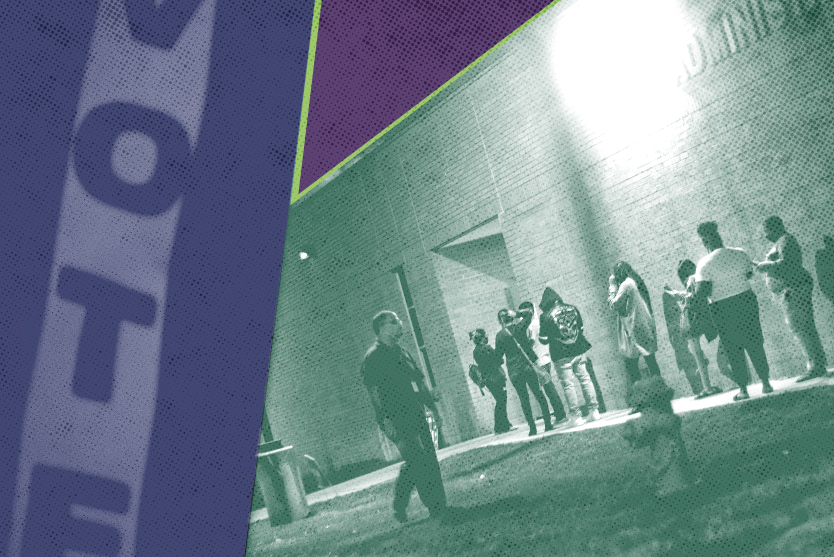Careful with those exit polls


It may be tempting, as you're doom-scrolling through swing state results trickling in at a glacial pace, to turn to exit polls. Don't do it. Or, if you do, read the rest of this post first and approach this data with all due caution.
Exit polls seem like a reliable source of information. After all, they're not advance surveys of self-proclaimed "likely" voters who may never actually vote. Traditionally, we think of exit polls as in-person, post-vote interviews whose findings are weighted to reflect local voter demographics.
The problem is that even with that adjustment — and sometimes exciting bits of data get out before any adjustment is made — exit polling at best offers an impressionist portrait of the vote. In 2016, for example, "exit polls estimated that the white working class cast a total of 34 percent" of ballots. Later, more accurate research put it at 44 percent, a significant difference. Likewise, the most famous number from the last presidential race, that 81 percent of white evangelicals voted for President Trump, wasn't exactly right. Better, later research put it about five points lower.
The Week
Escape your echo chamber. Get the facts behind the news, plus analysis from multiple perspectives.

Sign up for The Week's Free Newsletters
From our morning news briefing to a weekly Good News Newsletter, get the best of The Week delivered directly to your inbox.
From our morning news briefing to a weekly Good News Newsletter, get the best of The Week delivered directly to your inbox.
This year's exit polls deserve extra skepticism. One reason is the unusually high proportion of early and mail-in voting. Though the main exit polling firm, Edison Research, conducted phone surveys of mail-in voters and sent pollsters to early voting stations to account for this shift, it's difficult to say how accurate this methodology will be, particularly for fine demographic detail.
Another factor is voter behavior. Voters are less willing to participate in exit polls than they used to be, and there's no guarantee participants tell the truth. They might lie because loved ones can overhear them, because they find it funny, or because they think honesty will produce social blowback.
That brings me to a few titillating exit polls making the rounds as I write. One data set shows a dramatic swing of Hispanic voters away from the Democratic Party since 2016. Similarly, another finds "Trump did better in 2020 with every race and gender except white men." These are major shifts, if they hold. Some early vote counts as well as the very large margins in the Hispanic vote numbers suggest that swing is real. But the second data set is all moves of 5 percent or less. It might prove entirely right — or every number on the list may be dead wrong. We simply have to wait and see.
A free daily email with the biggest news stories of the day – and the best features from TheWeek.com
Bonnie Kristian was a deputy editor and acting editor-in-chief of TheWeek.com. She is a columnist at Christianity Today and author of Untrustworthy: The Knowledge Crisis Breaking Our Brains, Polluting Our Politics, and Corrupting Christian Community (forthcoming 2022) and A Flexible Faith: Rethinking What It Means to Follow Jesus Today (2018). Her writing has also appeared at Time Magazine, CNN, USA Today, Newsweek, the Los Angeles Times, and The American Conservative, among other outlets.
-
 Bulgaria is the latest government to fall amid mass protests
Bulgaria is the latest government to fall amid mass protestsThe Explainer The country’s prime minister resigned as part of the fallout
-
 Femicide: Italy’s newest crime
Femicide: Italy’s newest crimeThe Explainer Landmark law to criminalise murder of a woman as an ‘act of hatred’ or ‘subjugation’ but critics say Italy is still deeply patriarchal
-
 Brazil’s Bolsonaro behind bars after appeals run out
Brazil’s Bolsonaro behind bars after appeals run outSpeed Read He will serve 27 years in prison
-
 Americans traveling abroad face renewed criticism in the Trump era
Americans traveling abroad face renewed criticism in the Trump eraThe Explainer Some of Trump’s behavior has Americans being questioned
-
 Nigeria confused by Trump invasion threat
Nigeria confused by Trump invasion threatSpeed Read Trump has claimed the country is persecuting Christians
-
 Sanae Takaichi: Japan’s Iron Lady set to be the country’s first woman prime minister
Sanae Takaichi: Japan’s Iron Lady set to be the country’s first woman prime ministerIn the Spotlight Takaichi is a member of Japan’s conservative, nationalist Liberal Democratic Party
-
 Russia is ‘helping China’ prepare for an invasion of Taiwan
Russia is ‘helping China’ prepare for an invasion of TaiwanIn the Spotlight Russia is reportedly allowing China access to military training
-
 Interpol arrests hundreds in Africa-wide sextortion crackdown
Interpol arrests hundreds in Africa-wide sextortion crackdownIN THE SPOTLIGHT A series of stings disrupts major cybercrime operations as law enforcement estimates millions in losses from schemes designed to prey on lonely users


